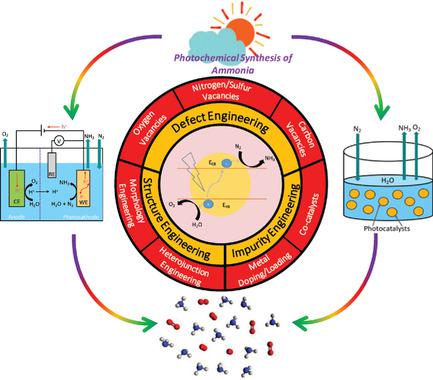当前位置:
X-MOL 学术
›
Small Methods
›
论文详情
Our official English website, www.x-mol.net, welcomes your feedback! (Note: you will need to create a separate account there.)
Photocatalysis and Photoelectrocatalysis Methods of Nitrogen Reduction for Sustainable Ammonia Synthesis
Small Methods ( IF 12.4 ) Pub Date : 2018-11-12 , DOI: 10.1002/smtd.201800352 Kemakorn Ithisuphalap 1 , Hanguang Zhang 1 , Lin Guo 1 , Qingui Yang 2 , Haipeng Yang 2 , Gang Wu 1
Small Methods ( IF 12.4 ) Pub Date : 2018-11-12 , DOI: 10.1002/smtd.201800352 Kemakorn Ithisuphalap 1 , Hanguang Zhang 1 , Lin Guo 1 , Qingui Yang 2 , Haipeng Yang 2 , Gang Wu 1
Affiliation

|
Ammonia (NH3) is one of the essential chemicals as a fertilizer and as a starting reagent for various chemicals with a production expectation of 200 million tonnes for 2018. With the development of renewable energy technologies such as hydrogen fuel cells, hydrogen also has emerged as an innovative clean energy source. Ammonia is a suitable hydrogen fuel carrier since a molecule of ammonia can carry up to three atoms of hydrogen. Recently, photochemical synthesis via nitrogen reduction has gained considerable attention as a sustainable method for the production of ammonia. The performance of the photoreduction of nitrogen lies in the developments of the photocatalysts and photoelectrocatalysts. Therefore, it is essential to understand the fundamentals of nitrogen reduction processes along with apprehending the challenges that limit the progress of catalysts. In this review, the basic understanding of photoreduction of nitrogen is highlighted, emphasizing on the challenges and effective methods to control defects, structures, and morphologies of materials for the catalyst development. The methods for ammonia detection and uncertainties in calculating the efficiency of the photochemical process are also addressed.
中文翻译:

氮合成的光催化和光电催化方法可持续合成氨
氨(NH 3)是必不可少的化学品之一,是肥料和各种化学品的起始试剂,2018年的产量有望达到2亿吨。随着氢燃料电池等可再生能源技术的发展,氢也已成为一种创新的清洁能源。能量源。氨是一种合适的氢燃料载体,因为氨分子最多可以携带三个氢原子。近来,通过氮还原的光化学合成作为生产氨的可持续方法已经引起了相当大的关注。氮的光还原性能取决于光催化剂和光电催化剂的发展。因此,了解氮还原过程的基本原理以及理解限制催化剂发展的挑战是至关重要的。在这篇综述中,强调了对氮的光还原的基本理解,着重介绍了控制催化剂开发用材料的缺陷,结构和形态所面临的挑战和有效方法。还讨论了氨检测方法和计算光化学过程效率时的不确定性。
更新日期:2018-11-12
中文翻译:

氮合成的光催化和光电催化方法可持续合成氨
氨(NH 3)是必不可少的化学品之一,是肥料和各种化学品的起始试剂,2018年的产量有望达到2亿吨。随着氢燃料电池等可再生能源技术的发展,氢也已成为一种创新的清洁能源。能量源。氨是一种合适的氢燃料载体,因为氨分子最多可以携带三个氢原子。近来,通过氮还原的光化学合成作为生产氨的可持续方法已经引起了相当大的关注。氮的光还原性能取决于光催化剂和光电催化剂的发展。因此,了解氮还原过程的基本原理以及理解限制催化剂发展的挑战是至关重要的。在这篇综述中,强调了对氮的光还原的基本理解,着重介绍了控制催化剂开发用材料的缺陷,结构和形态所面临的挑战和有效方法。还讨论了氨检测方法和计算光化学过程效率时的不确定性。



























 京公网安备 11010802027423号
京公网安备 11010802027423号